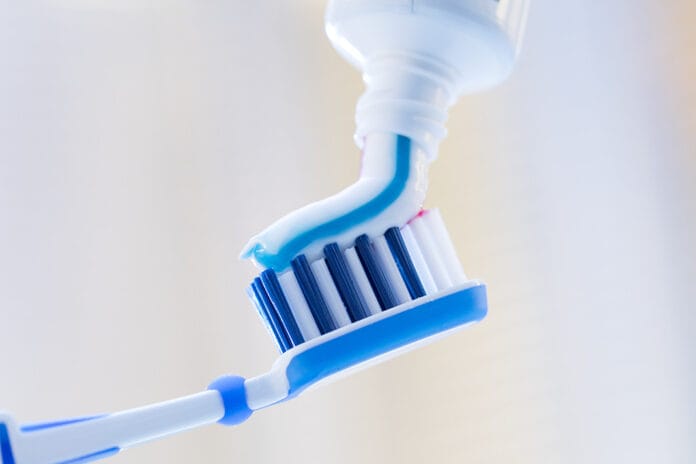Have you ever browsed the oral care section of a store and were completely overwhelmed with all the different types of available dentifrices? The variety includes an emphasis on whitening, sensitivity, charcoal, organic, and non-fluoride ‒ to name a few.
As a result, it is completely understandable when a patient inquires with a deer-in-the-headlight look, “What is the best toothpaste for me to buy?” Fortunately for the dental clinician, a knowledge of the active ingredients will aid us in deciphering the toothpaste that best suits a dental patient.
An awareness of the patients’ oral care needs in conjunction with understanding the toothpaste’s active ingredients will help determine the best recommendation. The following is a list of the most common toothpaste ingredients and the properties that address the dental patient’s needs.
Sodium fluoride ‒ Sodium fluoride is a Food and Drug Administration-approved “inorganic salt of fluoride used topically or in municipal water fluoridation systems to prevent dental caries.”1 Sodium fluoride binds to the calcium of the hydroxyapatite surface of the enamel, and it inhibits bacterial acid production that can cause erosion to the tooth surface. Although safe in low concentrations, higher concentrations of ingested sodium fluoride can interfere during the development stages of the tooth, causing enamel defects (also known as dental fluorosis).2
Stannous fluoride ‒ Stannous fluoride is also a Food and Drug Administration-approved “inorganic salt and a fluoride salt” used to prevent and repair dental caries lesions, prevent gingivitis, and decrease hypersensitivity.1 Although similar to sodium fluoride, stannous fluoride is more effective in enamel remineralization with incipient dental lesions.
Stannous fluoride also acts as a broad-spectrum antibiotic by effectively reducing bacterial microbes of dental biofilm.3 Typically, manufacturers of toothpaste that contain stannous fluoride promote its use for gingivitis, caries protection, hypersensitivity, and periodontal disease.
However, the drawback of toothpaste containing stannous fluoride is that if the stannous fluoride ion is not stabilized well, it can cause stain.15 Newer over-the-counter formulations stabilized with zinc phosphate technology reduce the risk of tooth staining, but prescription rinses and prescription dentifrices may not reduce the risk of stain.4, 15
Sodium lauryl sulfate ‒ Sodium lauryl sulfate is “a crystalline sodium salt of sulfated lauryl alcohol” that is “used as a detergent, wetting agent, and emulsifying agent (in toothpaste).”6 This synthetic detergent helps in lowering the surface tension and, in return, penetrates and loosens surface deposits.7
Unfortunately, due to the penetration of sodium lauryl sulfate in the mucosa, some dental patients may experience gingival tissue sensitivity and/or canker sores.8
Carbamide peroxide/hydrogen peroxide ‒ Carbamide peroxide, also known as hydrogen peroxide, is the active ingredient in most over-the-counter whitening toothpaste. Carbamide peroxide is “a water-soluble, white crystalline solid compound consisting of hydrogen peroxide and urea.”9 Although most over-the-counter toothpastes contain abrasives called silicas, they are only effective in polishing surface stains.10
Over-the-counter concentrations of carbamide peroxide toothpaste will whiten by one shade. In comparison, prescription-strength whitening formulations have concentrations of 10% to 30% in peroxides and can whiten anywhere from three to eight shades.10 However, the higher the concentration of peroxide, the greater the risk of soft tissue and tooth sensitivity.10 When a clinician advises the dental patient on choosing the best tooth-whitening options, it is important to reduce the risk of hypersensitivity due to the presence of enamel defects, a high rate of untreated caries, and gingival sensitivities, to name a few.
When recommending a tooth-whitening toothpaste to a dental patient, be mindful of any current sensitivities and recommend an American Dental Association (ADA) approved toothpaste. The ADA seal validates that the toothpaste is a safe and effective product.11
Charcoal ‒ Activated charcoal-enhanced toothpaste became available in the 20th century mainly for tooth-whitening purposes. The activated charcoal toothpaste consists of “fine carbon powder obtained from burnt coconut shells, olive pits, coal, sawdust, and hone char.” The principle behind the activated charcoal is that the negatively charged charcoal is attracted to the positively charged molecules of tooth stain and plaque, thus neutralizing the stain and plaque.12
In retrospect, the ADA has issued a warning concerning the activated charcoal toothpaste use due to its abrasive nature and the lack of fluoride present in the toothpaste, which can interfere in preventing tooth decay. Another risk factor includes the penetration of the charcoal toothpaste compound in the soft tissue crevices due to its gritty consistency, which, in turn, can cause the gingiva to react to its presence and invoke gingival inflammation and sensitivity.13
An extensive literature review found that charcoal toothpaste does not whiten teeth and can be detrimental to oral health.16 This systematic review noted that if the toothpaste does contain fluoride (only about 8% of charcoal toothpastes do), the charcoal inactivates the fluoride. “A growing number of researchers are concerned about the link between charcoal and cancer. Charcoal is classified as a carcinogen by many governments yet is the active ingredient in promoted charcoal toothpastes. Additionally, many brands of charcoal toothpaste feature crystalline silica, which is also recognized as a carcinogen.”16
Tetrasodium pyrophosphate ‒ Tetrasodium pyrophosphate is “an inorganic compound … as a salt, it is a white, water-soluble solid composed of pyrophosphate anion and sodium ions.”14 Tetrasodium pyrophosphate can be found in toothpaste, dental floss, and dental rinses as a tartar control agent.
Tetrasodium pyrophosphate aids in removing “calcium and magnesium from saliva and thus preventing them from being deposited on the tooth surface.”14 The risk factor consists of the toxicity of the chemical being “twice that of table salt when ingested orally.”14
Conclusion
Thorough knowledge of the active ingredients and their properties of available over-the-counter dentifrices is important for patient education and recommendations. Although this only touches the tip of the iceberg in reference to toothpaste ingredients and their properties, the best recommended over-the-counter toothpastes are those with the ADA seal of approval. With such a seal, the dental clinician knows the product is safe and that it will effectively prevent dental caries when used with proper at-home oral instruction.
Need CE? Check Out the Self-Study CE Courses from Today’s RDH!
Listen to the Today’s RDH Dental Hygiene Podcast Below:
References
- Sodium Fluoride. (n.d.). NIH: National Library of Medicine. Retrieved from https://pubchem.ncbi.nlm.nih.gov/compound/Sodium-fluoride
- Fluoride Topical and Systemic Supplements. (n.d.). American Dental Association. Retrieved from https://www.ada.org/resources/research/science-and-research-institute/oral-health-topics/fluoride-topical-and-systemic-supplements
- Stannous Fluoride. (n.d.). NIH: National Library of Medicine. Retrieved from https://pubchem.ncbi.nlm.nih.gov/compound/Stannous-fluoride
- Cherney, K. (2019, May 28). Stannous Fluoride in Toothpaste and Mouthwash: Pros and Cons. Heathline. Retrieved from https://www.healthline.com/health/stannous-fluoride
- A. Johannsen, A., Emilson, C-G., Johannsen, G., et al. Effects of Stabilized Stannous Fluoride Dentifrice on Dental Calculus, Dental Plaque, Gingivitis, Halitosis and Stain. NIH: National Library of Medicine. 2019 Dec. 9; 5(12). Retrieved from https://pubmed.ncbi.nlm.nih.gov/31872105/
- Sodium Laurel Sulfate. (n.d.). Merriam-Webster Dictionary. Retrieved from https://www.merriam-webster.com/dictionary/sodium%20lauryl%20sulfate
- Barkvoll, P. Should Toothpastes Foam? Sodium Lauryl Sulfate–A Toothpaste Detergent in Focus. NIH: National Library of Medicine. 1989; 99(3): 82-4. Retrieved from https://pubmed.ncbi.nlm.nih.gov/2696932/
- Sodium Laurel Sulfate Allergy. (2016, July 14). Allergy Symptoms. Retrieved from https://allergy-symptoms.org/sodium-lauryl-sulfate-allergy/
- Carbamide Peroxide. (n.d.). NIH: National Library of Medicine. Retrieved from https://pubchem.ncbi.nlm.nih.gov/compound/Carbamide-peroxide
- Mark, A.M. Getting Whiter Teeth. Journal of American Dental Association. 2017; 148(4): 280. Retrieved from https://jada.ada.org/article/S0002-8177(17)30095-8/fulltext
- Frisbee, E. (2021 October 31). Teeth Whitening. WebMD. Retrieved from https://www.webmd.com/oral-health/teeth-whitening
- Sahi, A. (2018, November 21). Charcoal Toothpaste: Benefits and Risks. News MedicLife Science. Retrieved from https://www.news-medical.net/health/Charcoal-Toothpaste-Benefits-and-Risks.aspx
- Brooks, J.K., Bashirelahi, N., Reynolds, M.A. Charcoal and Charcoal-based Dentifrice. Journal of the American Dental Association. 2017; 148(9): 661-670. Retrieved from https://jada.ada.org/article/S0002-8177(17)30412-9/fulltext
- Tetrasodium Pyrophosphate. (n.d.). Definitions. Retrieved from https://www.definitions.net/definition/tetrasodium+pyrophosphate
- Sergent, B. (2022, January 30). Dental Stain: Hygienists Can Ascertain Source, Help Increase Dental Patient Confidence. Today’s RDH. Retrieved from https://www.todaysrdh.com/dental-stain-hygienists-can-ascertain-source-help-increase-dental-patient-confidence/
- Charcoal Toothpaste Deactivates Fluoride, Abrasive, and Some May Contain Carcinogens. ((2019, June 28). Today’s RDH. Retrieved from https://www.todaysrdh.com/charcoal-toothpaste-deactivates-fluoride-abrasive-and-some-may-contain-carcinogens/









